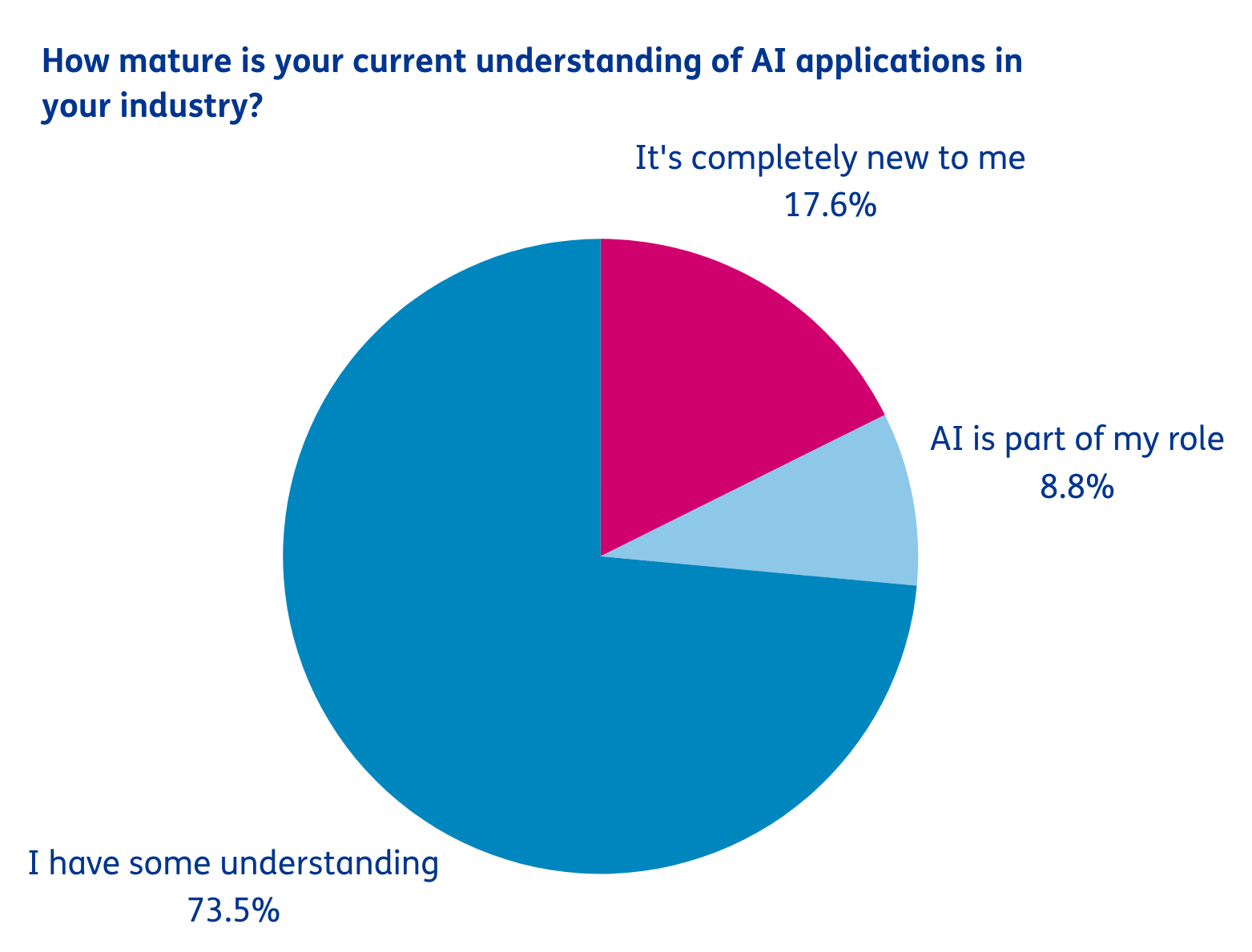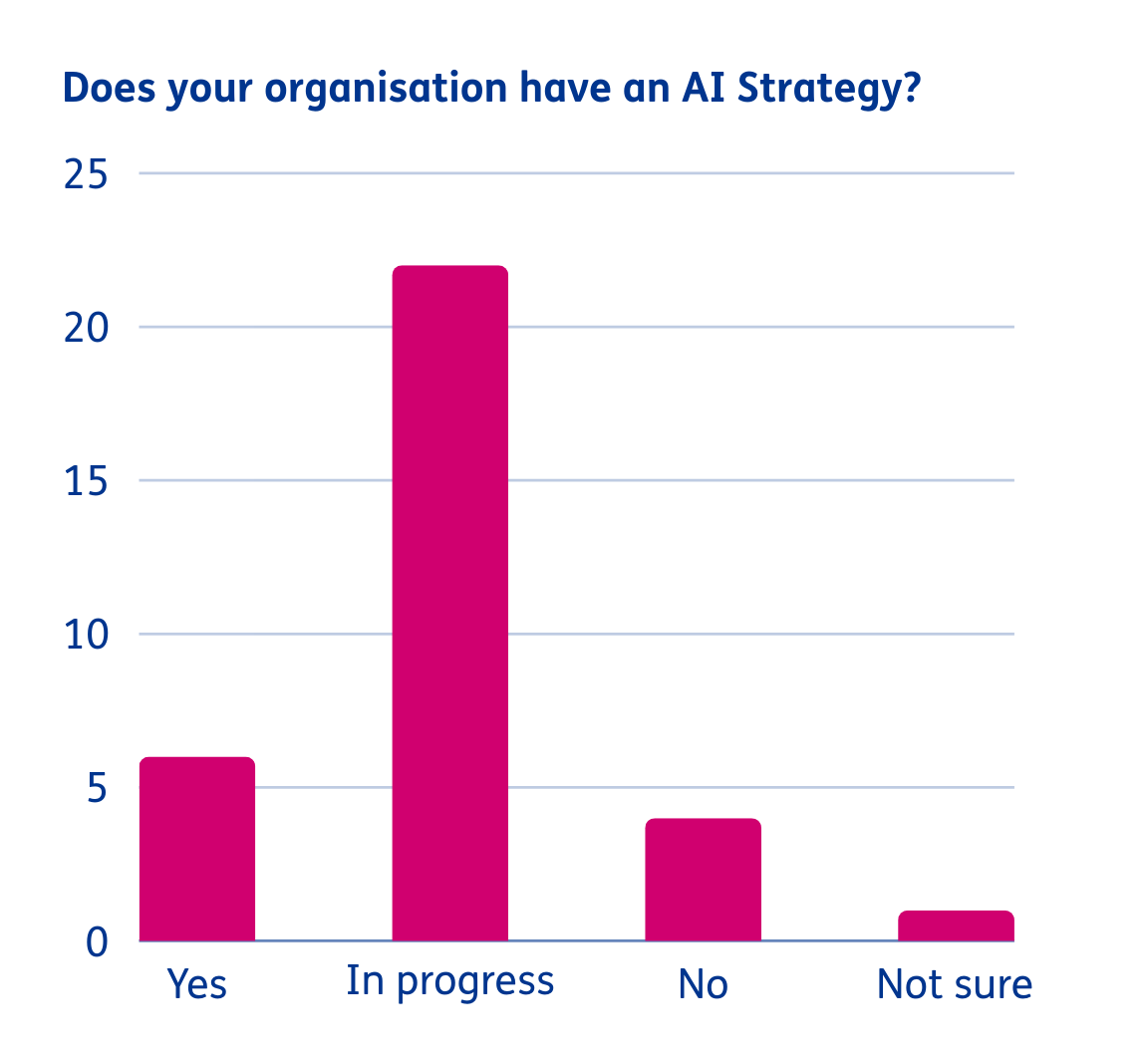AI is transforming the technology, media, and telecoms (TMT) space, offering new opportunities for growth and innovation. With the generative AI market projected to reach $1.2 trillion by 2032, TMT companies are clearly eager to harness its potential. However, with AI's rapid development come risks and uncertainties that must be carefully navigated.
This poses important questions for companies. How can we use AI to increase revenue? How can it help us cut costs? And what risks do we need to manage along the way?
Front of mind for executives
At our recent Senior Women in TMT event, it was clear that AI is high on the executive agenda. A live poll of the 30+ women from 25+ organisations in attendance revealed that most TMT businesses are relatively early in their AI journeys. Around three-quarters (74%) of participants said they have only some understanding of AI applications in their industry. And two-thirds (67%) said their organisations are currently developing AI strategies. 

The poll found that participants felt “excited”, “intrigued” and “curious” about AI. However, the discussions also revealed a significant disparity between companies that have started implementing their AI strategies and those still figuring out what they can do.
Exploring a whole new world of possibilities
Many companies feel overwhelmed by AI’s potential. After all, it opens up entirely new ways of generating revenue, adding value, improving service quality and boosting employee engagement.
For instance, AI enables proactive, highly personalised communication with customers, along with improvements to user experience. It can enhance monetisation of existing content, plus produce new AI-generated content. And it delivers a competitive edge in tenders by allowing companies to work out what makes a successful RFx response, then replicate those approaches.
So far, only a few TMT businesses have seized these game-changing opportunities to drive revenue growth and improve customer service. Most are currently focused on using AI to cut costs and streamline tasks. Examples include writing job specifications, localising content for different audiences, speeding app development and filtering through supplier responses to an RFx. In the majority of these cases, AI does the legwork, then employees review the results. This dramatic shift in working patterns can send productivity soaring.
These opportunities are particularly exciting for TMT businesses, because the jump from the status quo to generative AI may be larger than in some industries. This means that the transformation and the value derived will be huge.
Staying on top of risk
Capitalising on these opportunities requires navigating risks that have emerged from AI’s rapid development. For instance, left unchecked, AI can mimic and amplify bias. Companies need to make sure that humans have a chance to intervene if algorithms make bad decisions.
Ownership is another thorny issue, particularly in the media industry. In the absence of regulation, there’s no consensus on whether rights for AI-generated content should sit with the people generating it, or those who produced the original content on which the models were trained.
There is tremendous value in coming together as an industry to solve these challenges and discuss use cases for the greater good. This is key to maintaining integrity and safeguarding trust from shareholders, customers and employees.
The issue of trust is particularly important in the media industry, given that AI’s impact on creative jobs remains unclear. This topic has already come to the fore in the recent Hollywood writers’ strike. As governments and policymakers take part in AI Safety summits – the first of which took place recently – they’ll need to discuss solutions to mitigate employment risks. For instance, that might mean retraining people currently in creative jobs to perform other highly important roles.
It's time to act
Even with so many unanswered questions, AI is driving such rapid change that companies can’t afford to ignore it. And with such a massive gap already emerging between AI leaders and laggards, organisations need to start work now or risk getting left behind.
So far, the vast majority of TMT businesses are only scratching the surface of AI’s potential. Many are introducing automation in pockets to streamline repeatable tasks, especially in customer experience, HR, sales, marketing, ops and security. But soon, we’ll see businesses automating more of their end-to-end processes.
How can businesses make this leap to take advantage of the next wave of AI innovation? By focusing on three areas:
- Finding and training enthusiastic people to understand the opportunities and develop a strategy to capitalise on them
- Transforming ways of working
- Communicating this shift to employees and end-users across all touchpoints to get everyone on board.
To find out more about the use of AI in your business, please reach out to a member of the team below.
Our Experts



Related Insights

Turbocharging the supply chain
Why network operators are investing in this capability to support the next wave of growth and innovation (and what to focus on now)…
Read more
A tipping point for telco cyber security
Four priorities security leaders need to be adopting to succeed in this complex and high-risk environment.
Read more
Lessons from other sectors for network operators
Rob Bradford, Supply Chain Procurement Director at Baringa, discusses supply chain opportunities for network operators, as well as how telcos can learn from other sectors.
Read more
Networks capability in telcos
Watch video of Baringa's Rob Bradford talking about the networks capability in telcos
Read moreRelated Case Studies

Digital transformation of a global insurance company’s IT infrastructure
How do you fully refresh and upgrade IT to help employees and critical systems?
Read more
Helping a telco turn digital transformation into competitive edge
How can a large telco unlock the advantages of digitalised operations and agile ways of working?
Read more
Deploying critical IT Infrastructure to enable a global cosmetics organisation to operate in China’s c£3.5Bn market
How can you set up your IT infrastructure to run in China?
Read more
Delivering strategic enterprise transformation at a major UK telecommunications firm
How do you design, steer and support a multi-million pound transformation programme?
Read more